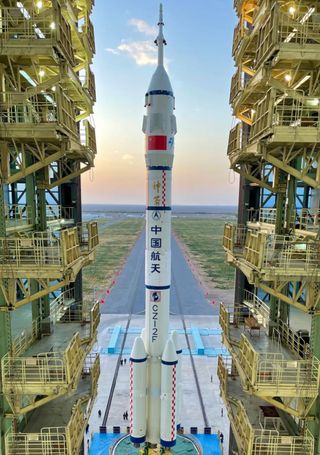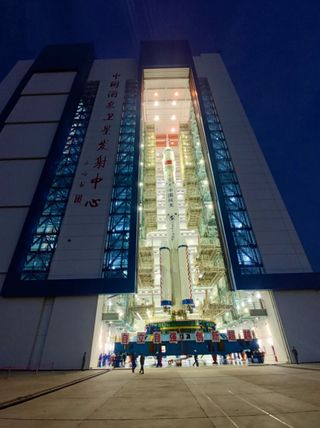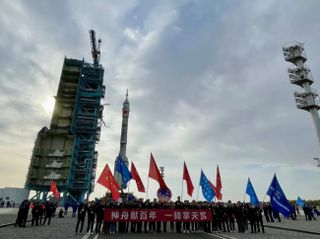China rolls out rocket for its longest crew mission yet
China has rolled out a rocket to the pad to send three astronauts from the desert up to its new Tianhe space station core module, although the launch date remains a mystery.
A 203-feet-high (62 meters) Long March 2F rocket was vertically transferred to the pad at Jiuquan Satellite Launch Center in the Gobi Desert early on Thursday (Oct. 7).
Atop the rocket is the Shenzhou 13 spacecraft that will carry the three astronauts into orbit. Visible at the top of the payload fairing is an escape launch system that can rapidly carry the spacecraft away from the rocket in case of an emergency early in the flight.
Related: The latest news about China's space program

The crew has not yet been announced but is expected to be the backup crew for the recently completed Shenzhou 12 mission.
If correct, that would see astronauts Zhai Zhigang, Wang Yaping and Ye Guangfu fly to the Tianhe space station module, which launched in April and has so far hosted one, three-month-long crewed mission. This would be Ye's first flight; Wang would become the first female astronaut to visit Tianhe.

The mission's launch window has not yet been announced, however. Liftoff will coincide with a pass of Tianhe over Jiuquan, allowing Shenzhou 13 to catch up with and dock with the module hours later. Airspace closure notices may be the first clear signal as to when the mission will launch.
Get the Space.com Newsletter
Breaking space news, the latest updates on rocket launches, skywatching events and more!
Once aboard the 54-foot-long (16.6 m) Tianhe module the crew will be expected to stay for up to six months as part of the construction and verification phase of China's space station project. This visit would double China's current human spaceflight mission duration record, which was recently set by Shenzhou 12.

Tianzhou 3, a cargo spacecraft, docked with Tianhe on Sept. 20, delivering nearly 13,230 pounds (6,000 kilograms) of supplies, provisions, experiments and equipment for the Shenzhou 13 mission.
The rocket for the mission is the 13th Long March 2F. It is China's first to be prepared for both emergency rescue and launch. The rocket had been vertically assembled and in a state of near-readiness at Jiuquan since launch of Shenzhou 12 in June. It would have been able to launch at short notice in the case of an emergency in orbit.

"The advantage of vertical transfer lies in that the rocket and spacecraft could retain their technical status after testing in the technical area, thus minimizing state transition while saving the test preparation time to the launch area," Liu Feng, deputy chief designer of the Long March 2F Rocket, told CCTV.
China space watchers also noticed in press release photos published by the China Manned Space Agency (CMSA) that the next Long March 2F, for Shenzhou 14, had been assembled in the vertical integration building at Jiuquan, meaning it will be on standby in the case of emergencies.

The facilities at the launch site are in good condition, according to CMSA. Pre-launch function checks and joint rocket and spacecraft tests will be carried out as part of launch preparations.
The mission will be the fifth of 11 planned missions to build the Chinese space station. Two new modules, named Mengtian and Wentian, will launch and join with Tianhe in orbit in 2022.
Follow us on Twitter @Spacedotcom and on Facebook.
Join our Space Forums to keep talking space on the latest missions, night sky and more! And if you have a news tip, correction or comment, let us know at: community@space.com.

Andrew is a freelance space journalist with a focus on reporting on China's rapidly growing space sector. He began writing for Space.com in 2019 and writes for SpaceNews, IEEE Spectrum, National Geographic, Sky & Telescope, New Scientist and others. Andrew first caught the space bug when, as a youngster, he saw Voyager images of other worlds in our solar system for the first time. Away from space, Andrew enjoys trail running in the forests of Finland. You can follow him on Twitter @AJ_FI.
